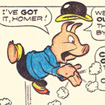I love splash pages...it's something you don't see much anymore, but you see them in just about all these old Frankenstein comics. Briefer's splashes are simple and effective.
An acknowledgment is given to "Bruce Elliott" for his help with the stories in this issue, but it doesn't specify what help was given. Inking? Plotting? Anyone out there familiar with Bruce Elliott?
I have to take issue with the cover's proclamation of "52 pages of action and fun"...there are only 43 pages of Frankenstein, the front cover, and a house ad (I'll allow that) for a total of 45 pages. 47 if you count the 2-page text story (I will but don't want to...it has nothing to do with Frankenstein. Pure filler). The rest are ads. The 52-page books were actually 48-page books, but with both sides of the front and back cover counted as additional pages. When Dell claimed 52 pages of comics, there were comics printed on those covers, not ads.
Still, it's a small complaint. A 52-page comic with no ads would probably run at least 7 or 8 bucks now, while this great old comic cost a dime.
By the way, I brightened up the scans of the first three stories, so you might want to take another look at them. I think I improved the readability a bit!
This is the last of four stories in this issue.
Here is "Frankenstein and the Time Machine" from Frankenstein #3 (July-August 1946):
































































Bruce Elliott was a magician and part-time writer.
ReplyDeleteBesides helping with plotting this comic (and a couple of other Frankensteins) as well as several Green Lama tales, he ghost-wrote (as Maxwell Grant) a number of The Shadow pulp stories when Walter Gibson began tiring of a two-book a month schedule, and took over writing the 1940s Shadow comic book.